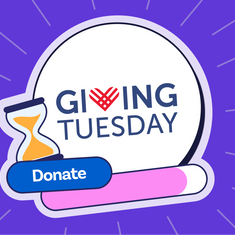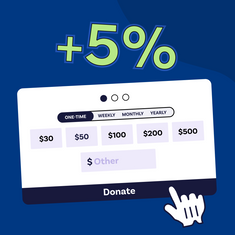
In order to retain your donors, you need to make sure they feel like people, not ATMs. Here are five ways to make the donation experience more meaningful.
Let’s compare two scenarios.
Scenario 1: Maya learns about a new nonprofit through social media and wants to support its mission. She uses the organisation’s website to donate. A few months go by with no word from the nonprofit. Then, Maya receives an email from a staff member requesting another donation. Put off by what feels like an insincere cash grab, Maya decides she won’t be giving to the organisation again.
Scenario 2: A staff member sees that Maya has been engaging with their nonprofit’s social media posts and reaches out to her with a personal message. When the staff member learns Maya loves to run, they invite her to attend an upcoming 5K fundraiser, and she has a great experience. Soon, she receives a personalised “thank you for attending” message. Maya signs up for the nonprofit’s monthly giving program and starts volunteering with them on the weekends.
What is the defining difference between these two scenarios? In the first, Maya was treated like an ATM instead of a person contributing to an important cause—there was nothing personal or meaningful about her donation experience. But in the second scenario, Maya felt seen and appreciated by the nonprofit before, during, and after the donation experience, which encouraged further engagement.
Making the donation experience meaningful for each and every one of your donors is a smart fundraising move. As illustrated by Scenario 2, it will pay dividends as you form long-lasting relationships with your community and garner more support for your cause.
In this guide, we’ll look at five tips for improving the donation experience:
- Get to know your donors.
- Plan fundraising campaigns your donors will love.
- Personalise your donation appeals.
- Make it convenient to donate.
- Thank your donors.
Nonprofit work is all about inspiring people to rally beyond your cause and help you move your mission forward. But for your organisation to be successful in achieving its mission, you need people on your side that are truly committed to what you stand for. It all starts with a meaningful donation experience.
Get to know your donors.
To make a donation experience personally meaningful to a supporter, you have to get to know them first. You can do so in a number of ways.
The first is to take a look at the current donor data in your CRM. This is where you store information about your donors’ contact details, donation and involvement history, personal interests and values, demographics, and more.
Even basic details like these can set you on the right track. For example, perhaps you store information in your CRM about your donors’ communication preferences. You could start personalising the donation experience by segmenting your donors by preference and designing more targeted marketing campaigns that encourage donors to give.
Another way to get to know your donors is to conduct prospect research. Usually prospect research is used to identify new supporters who might be in a position to give a major gift to your organisation.
According to Donorly’s prospect research guide, you’ll need to use prospect research tools to find potential donors with capacity markers (business affiliations, real estate ownership, stock holdings, etc.) and affinity markers (political giving history, past donation history to other nonprofits, etc). Prospecting will be especially useful during large-scale campaigns, like capital campaigns.
A final method of getting to know your donors that we’ll highlight here is to send them surveys. After all, why wait to find out what your donors need from you to improve their donation experience? Take the guesswork out of the equation and just ask!
You can ask questions like, “How could we improve our donation page so it’s easier to use?” or “How do you hear about our fundraising campaigns?” Gathering feedback in this way can help you get a leg up on your efforts to improve your tools and processes.
Plan fundraising campaigns your donors will love.
You may have a great turnout at your annual gala, but your supporters might actually be more enthusiastic about an annual golf tournament or TEDTalk-style speaker night. Or, your nonprofit might be considering a text-to-give campaign when your donors would find the supporter journey of a peer-to-peer campaign much more rewarding.
Planning campaigns with a mindset of “What will my supporters love?” can boost your donors’ enthusiasm. And that boosted enthusiasm can translate into increased support—whether your donors are giving more or spreading the word about your cause to family and friends, expanding your support base.
To get an idea of what types of campaigns your supporters truly enjoy, you can always leverage the surveying strategy mentioned in the previous section. But you can also use information from past campaigns to plan future initiatives. We recommend you look at the following fundraising campaign metrics to do so:
- Campaign Participation Rate
- Cost Per Dollar Raised
- Gifts Secured
- Pledge Fulfillment Percentage
- Online Gift Percentage
Learning from past campaign data can help you more effectively and efficiently design campaigns that will excite your supporters and, as a result, fill your fundraising calendar with opportunities for increased success. Check out this nonprofit fundraising KPIs resource from DonorSearch to learn more about how to calculate these metrics.
Personalise your donation appeals.
When you make an effort to personalise your donation appeals, you’re really making an effort to recognise donors as individuals rather than a collective mass. This strategy can help ensure your donors feel like they are seen and valued by your organisation as people rather than blank checks, which can lead to more sustainable relationships and support.
Here are a few different ways you can go about personalising your fundraising asks:
- Use the channel that your donors prefer. Segmenting your donors by communication preference can add a personal touch to donation appeals. For example, some donors may prefer to receive a text with a link to your donation page because it’s easiest for them to give. Another donor might prefer a phone call from a staff member where they can get updates on your work and then give.
- Skip “Dear Donor” and use first names. Using a person’s name is a small move that can make a big difference. It assures the donor the “ask” is meant specifically for them and not just anyone. You can automate the inclusion of donor names as you create donation letters, social media messages, and emails. You can even do this on your website using merge fields.
- Highlight past support before asking for more support. If someone has given to your organisation before, you should thank them for that support before asking for more! Acknowledging past donations, volunteer work, or event attendance can go a long way in helping a donor feel appreciated by your nonprofit.
- Have the ask come from a real person. When reaching out to solicit a donation, it can be effective to have that ask come from a specific staff member or volunteer instead of your organisation as a whole. It makes the process feel more human and authentic.
You can also personalise your donation appeals by following up with a sincere thank-you message right after a donor gives—even if it’s automated! Include your donor’s name and the donation amount to show that your organisation recognises and appreciates that specific donor’s contribution.
Make it convenient to donate.
You can show your donors that they’re top of mind by making the actual giving process fast, easy, and convenient. This communicates that you’re mindful of your donors’ time and grateful for every gift they choose to contribute.
Here are a few suggestions for making your donation process convenient:
- Leverage the right tools. You likely have numerous donation tools you rely on to secure donations—but are they the best tools for convenient giving? For example, you might consider investing in a solution that offers digital wallets. Digital wallets allow donors to use Apple Pay, Google Pay, and PayPal instead of having to type card information into their devices.
- Optimise your donation form. Make your donation form the best it can be by leaning into simplicity. We suggest setting up a three-step method. First, donors choose their donation amount and frequency. Next, they enter contact and payment details. And the last step of the process is completing the payment.
- Offer different giving options. Donors love to have choices. Give them a chance to opt into your recurring giving program, use a matching gift tool, or dedicate their donation to a loved one.
- Get creative. Breathe some new life into the donation process your organisation offers by thinking outside of the box. For example, you might host an old-fashioned telethon, invite a board member to match online gifts to a certain amount, or offer QR codes as a way to get to your donation form.
As you’re making changes to your donation process, seek some informal feedback. Ask a staff member or volunteer to test out your tools and let you know what the experience was like. This can help you prepare your tools to give your donors the best experience possible.
Thank your donors.
It’s all well and good to make your donation experience meaningful. But without an eye to the future and a focus on gratitude, you’ll have a hard time retaining the support of your donors for the long haul.
This is why it’s mission-critical to thank your donors quickly and sincerely. You can do this in a number of ways, from writing thank-you notes or making phone calls to creating personalised thank-you video messages. But no matter what shape your thank-you efforts take, there are some essential elements you’ll need to include:
- The donor’s name
- Acknowledgement of the donation date and donation amount
- Description of what your organisation is trying to accomplish and how the donation will help
- Invitation to continue engaging with your organisation
- Signature (Bonus points if this is a handwritten signature from someone at your nonprofit!)
Sending out donor thank-yous caps off a genuinely meaningful donation experience. This is because you’ll remind your donors that their contributions are going toward something specific and recognise them as individuals who gave generously to an important cause.
As a nonprofit, you know that donations are important. But examining the donation experience from the perspective of a donor highlights the importance of adding meaning and sincerity into the process.
By incorporating these tips into your own strategy, you’ll be well on your way to building long lasting donor relationships that can benefit your organisation for years to come.
Stay in the loop. Delivered to your inbox twice a month.

Content marketing lead at Raisely.




